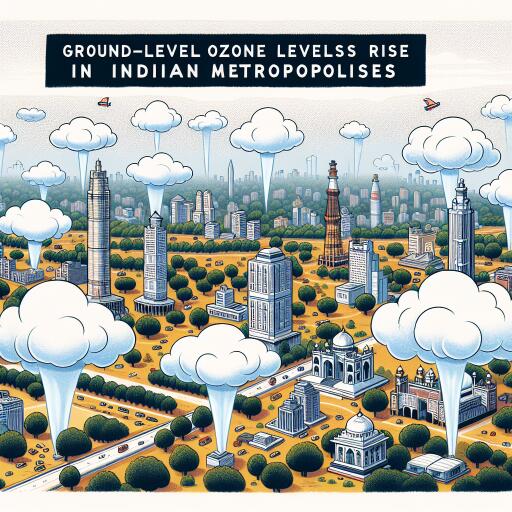
Ten Indian Metropolitan Areas Witness Surge in Ground-Level Ozone Pollution
A recent investigation into air quality across India has unveiled a concerning rise in ground-level ozone across ten of its largest metropolitan regions, signaling an increasing environmental and public health challenge. Ground-level ozone, a key component of urban smog, has shown a worrying increase, particularly during the summer months of 2024, with implications that could stretch far and wide over the health of millions and the efficacy of ongoing air quality management efforts.
Ozone at ground level is not emitted directly but is formed when nitrogen oxides (NOx) and volatile organic compounds (VOCs), emitted by vehicles, industrial facilities, and other sources, react under sunlight. This colorless gas has been linked to numerous health issues, particularly exacerbating respiratory conditions such as asthma, bronchitis, and chronic obstructive pulmonary disease.
The study highlighted a staggering 17% increase in ground-level ozone concentrations across India from 2010 to 2017, with all ten metropolitan areas recording exceedances of safe limits. Among the cities flagged were Delhi-NCR, which led the pack, followed by other major areas including the Bengaluru Metropolitan Area in Karnataka, Chennai Metropolitan Area in Tamil Nadu, and Mumbai Metropolitan Region in Maharashtra, to name a few. Notably, the city of Ahmedabad witnessed an unprecedented 4,000% surge in ground-level ozone exceedances, underscoring the spread and severity of the issue.
The findings cast a new light on the challenges facing the National Clean Air Programme (NCAP), stressing the need for an integrated approach to tackle the multitude of pollutants contributing to urban air pollution. An expert from the Centre for Science and Environment (CSE) emphasized the critical need for a refined action strategy that addresses the coexistence of particulate matter, ozone, NOx, and other pollutants, to harness the full benefits of national clean air endeavors.
The extensive geographical spread of elevated ozone levels beyond the usual summer months, especially in southern and western coastal metropolitan areas, indicates a broadening of the environmental challenge. The persistence of high ozone levels, even during night hours in all ten metropolitan areas, marks a significant divergence from the expected drop in ozone concentrations after sunset. Mumbai-MMR reported the highest number of nights with ozone levels surpassing the safe threshold, closely followed by Delhi-NCR and Pune.
Interestingly, the study also shed light on the distribution of ozone pollution across different neighborhoods, finding that more affluent and greener areas are not immune to high levels of ground-level ozone. This pattern underscores the complex dynamics of ozone formation and dispersion, which can result in higher concentrations in areas with fewer direct sources of NOx and VOC emissions.
In response to these findings, experts are calling for urgent action to develop a robust public information system to alert citizens about ozone exceedance events and push forward comprehensive plans to mitigate NOx and VOC emissions. The study underlines the urgent need for policies and measures that address the unique challenges of ground-level ozone pollution, reinforcing the importance of multi-pollutant control strategies to safeguard public health and environmental quality in India’s rapidly urbanizing cities.
The situation underscores a vital call to action for immediate measures to curb the emissions leading to ozone formation and to safeguard public health against this invisible but growing threat. With concerted effort and integrated policies, it is possible to tackle the rising challenge of ground-level ozone pollution across India’s metropolitan landscapes.





Leave a Reply